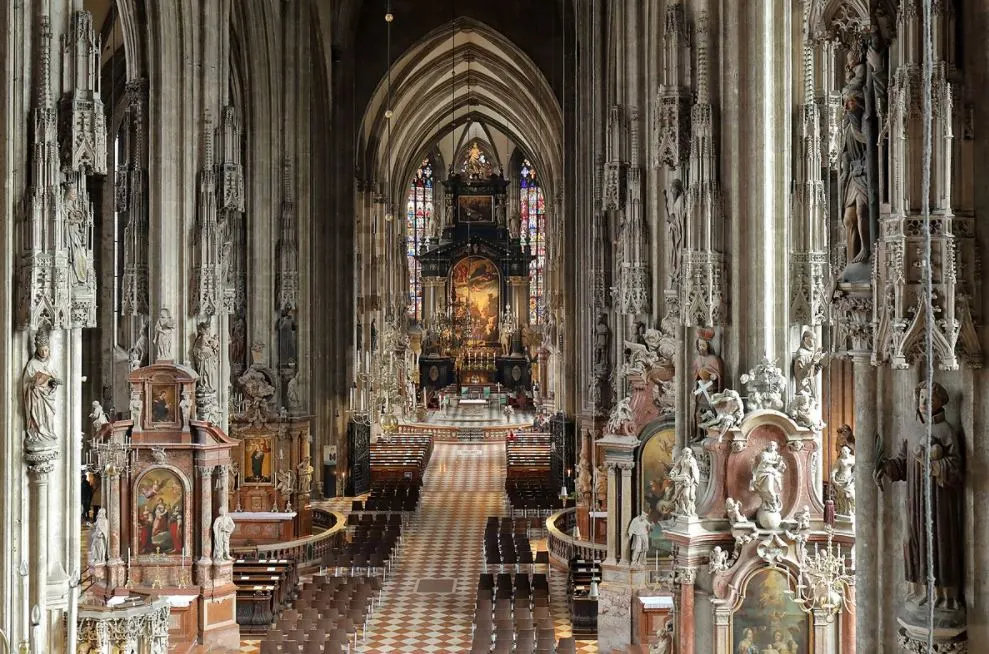One of the most fascinating Gothic Cathedrals in the world can be found in the historical heart of the capital of Austria, Vienna.
In this post, you’ll discover the ultimate list of interesting facts about St. Stephen’s Cathedral, an amazing church with a remarkable history commonly known as the Stephansdom.
1. The original church was built on an Ancient Roman cemetery
During the reign of Roman Emperor Augustus, in the year 15 B.C., the Romans built a fortified structure to protect a military camp that they had built on the site where the Austrian capital of Vienna is located now.
They referred to the city they had founded as “Vindobona,” which translates to “fair village, white settlement,” and which is probably how modern-day Vienna got its name.
It’s only during the year 2000 that ancient graves were discovered about 2.5 meters (8.2 feet) below the surface. This means that the cathedral was built on the remains of an ancient Roman cemetery.

2. The Romanesque towers were completed in the mid-13th century
The original church on the site was built in the 12th century in the Romanesque architectural style. It was founded in the year 1137 and the initial construction phase was completed in 1147, which is the year the church was dedicated to Saint Stephen.
This was an important event as it was the moment that Conrad III of Germany and his gang were getting ready to start their Second Crusade (1147-1150).
The first church on the site was completed in the year 1160 and subsequently expanded between 1230 and 1245. This is when the 2 magnificent Romanesque towers we can still see today were completed.
These towers stand 65 meters (213 feet) tall and are commonly referred to as the “Heidentürme,” a reference to the fact that they were built on top of the Roman fortification. “Heiden” translates to “Pagans,” so “Pagan Towers.”
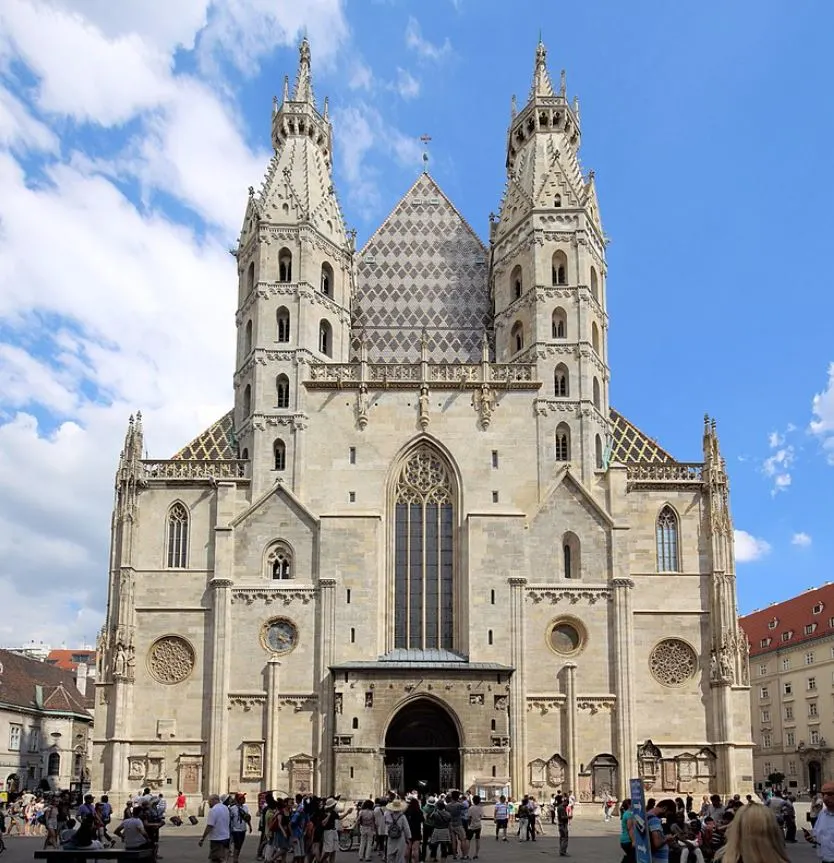
3. The second church here dates back to the 13th century as well

Even though the two Romanesque towers were completed in 1245, the structure around them doesn’t date back to this period. That’s because a great fire destroyed much of the structure in 1258, except for these two towers.
The towers were simply incorporated into an even bigger structure which was completed and dedicated shortly after on April 23, 1263.
One of the most remarkable facts about St. Stephen’s Cathedral is that this dedication in the 13th century is still commemorated every year. On this day, the big bells inside the tower ring for 3 minutes straight.

4. The Gothic church we see today was finally completed in 1511
It didn’t take long before another expansion phase was started, this time in the Gothic architectural style. In the early 14th century, King Albert I commissioned the Gothic choir which consists of 3 naves.
This work was completed between 1304 and 1340 and dedicated by Albert’s son, Albert II. This wasn’t enough because Albert I’s grandson, Rudolph IV or “Rudolph the Founder,” started the construction of the westward Gothic extension of the church.
The overall design of the church we see today with all its features was completed in 1511, the year that construction on the cathedral was halted altogether.

5. The main spire reaches the height of a modern-day skyscraper
During the final expansion phase, the church was seriously enlarged. It has a total length of 107 meters (351 feet) and a width of 70 meters (230 feet).
The most prominent feature of this fascinating cathedral is the southern tower of which the spire reaches a height of 136.7 meters (448 feet).
This tower was completed in 1433 and its height is the equivalent of an amazing skyscraper which turns it into the most dominant building in the area.

6. The north tower was intended to resemble its taller brother
The church could have been even more imposing if the original plan was completed. This would have turned the north tower into the twin brother of the south tower, but this plan was eventually abandoned when work stopped in 1511.
The construction of this tower started in 1450 and it eventually reached a height of 68.3 meters (224 feet). Because the original plans were abandoned, this tower was topped with a Renaissance roof in the year1568, a common feature during the 16th century.
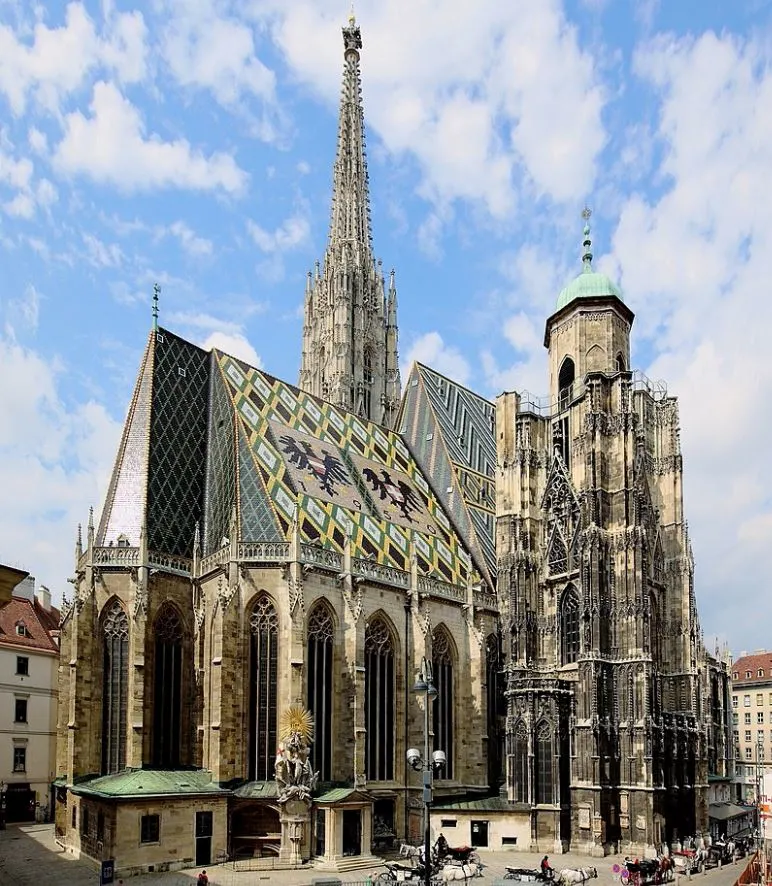
7. The main door is probably named after a prehistoric animal
The main entrance of the church has its own name as it’s referred to as the “Riesentor,” or the “Giant’s Door.” There are a couple of theories as to why it’s referred to as such, but it’s assumed that it refers to the thighbone of a mammoth, a giant prehistoric animal.
This thighbone was excavated during the construction in 1443 and dangled above this door for multiple decades. To both sides of this door, we can find the old Romanesque towers from the 13th century.

8. The most amazing feature of the church is its tiled roof
One of the most amazing facts about St. Stephen’s Cathedral is that it features a magnificent roof that is covered with a total of 230,000 glazed tiles.
This roof has a length of 111 meters (364 feet) and the south side depicts the symbol of the Austrian Empire under Habsburg rule, the double-headed eagle.
The north side of the north depicts the coat of arms of both the City of Vienna and the Republic of Austria, a remarkable sight to behold!

9. It’s home to the third-largest swinging bell in Europe
The cathedral’s towers are home to a total of 23 ringing bells. The largest of them all is called the “Pummerin,” or “Boomer,” and is located inside the north tower.
The original Pummerin was cast from 208 cannons captured by Muslim invaders during the Second Turkish Siege of Vienna in 1683. This enormous bell weighed 18,161 kilos (40,038 lbs) and it took over 15 minutes for 16 men to pull on a rope for the bell to ring.
Unfortunately, this old bell was destroyed in the aftermath of World War II and replaced with the “New Pummerin” in 1951. The new bell weighs even more at 20,130 kilos (44,380 lbs), a weight that makes it the third-heaviest swinging bell in Europe.
Only the Petersglocke in Cologne Cathedral (23,500 kg / 51,810 lbs) and the Maria Dolens (22,700 kilos / 50,044 lbs) in Rovereto, Italy, are heavier.

10. A presumed miracle brought a Hungarian icon to the church
The interior of the cathedral is equally impressive as the exterior and multiple famous works of art can be found here. One of these is the “Pötscher Madonna,” a Byzantine-style icon of St. Mary with baby Jesus that
It was created in 1676 and brought to the church in the late 17th century from the church of Pócs in Hungary for a particular reason.
After Holy Roman Emperor Leopold I received the word of the icon shedding tears on two different occasions, he ordered him to be brought to Austria. It arrived in Vienna after a 5-month journey in 1697 but hasn’t been seen shedding tears since.
It can now be found in the southwest corner of the nave of the cathedral.

11. The 15th-century Altar underwent a costly 20-year restoration
The High Altar is the first one a visitor notices when entering the church. This Baroque altar was completed between 1641 and 1647 and represents the stoning of Saint Stephen, the martyr to whom the church was dedicated.
The other famous altar in the church is the so-called Wiener Neustädter Altar, an altar that was commissioned by Emperor Frederick III in the year 1447.
This altar wasn’t moved to the cathedral until 1885 as it originally decorated the Cistercian Viktring Abbey near Klagenfurt (until 1776) and the Cistercian monastery of St. Bernard of Clairvaux in Wiener Neustadt.
On its 100th anniversary in the church in 1985, a restoration program was started which would take 20 years to complete for 1.3 million euros.
It’s only opened during weekends and opened up it depicts events in the life of the Virgin Mary. If closed, it depicts a painting involving 72 saints.
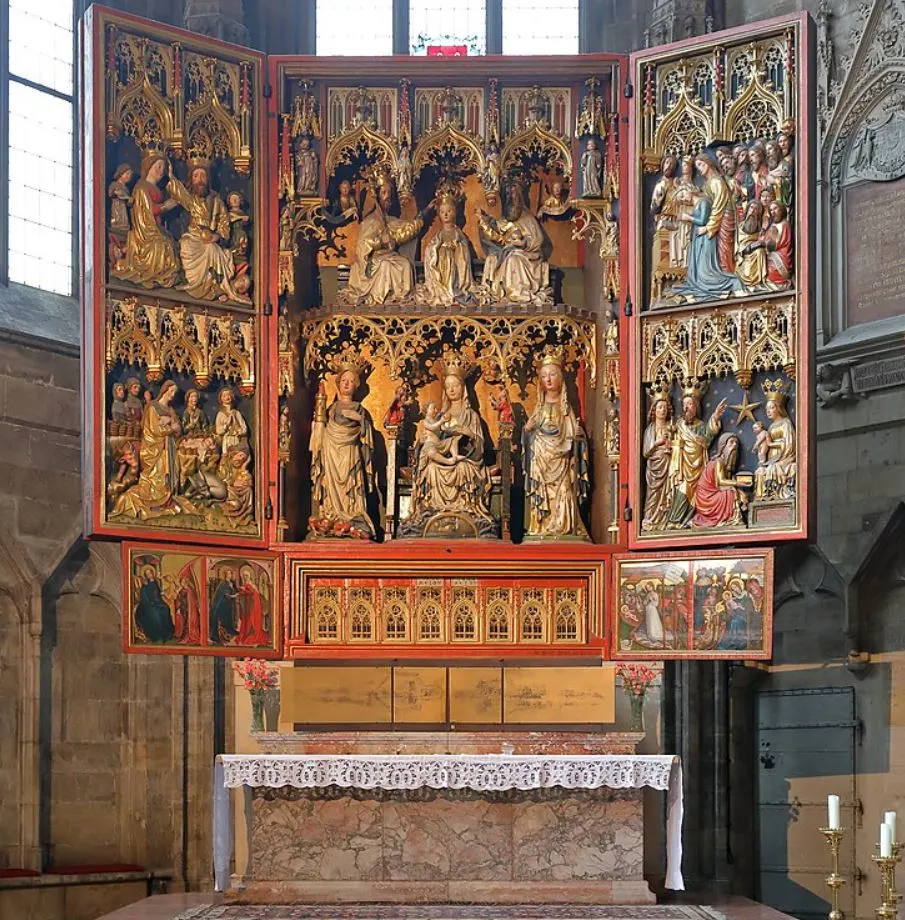
12. A sculptor probably eternalized himself below the pulpit’s chair
One of the most remarkable works of art is the stone-cut pulpit which is situated against one of the pillars of the nave of the cathedral. The sculptor is believed to be Dutch-born Nikolaus Gerhaert (1420-1473), but he didn’t manage to steal the show so-to-speak.
Below the pulpit, we can see the image of a man peaking through a window. This is believed to be a self-portrait of an unidentified sculptor who is referred to as the “Fenstergucker,” or “Window Peaker.”
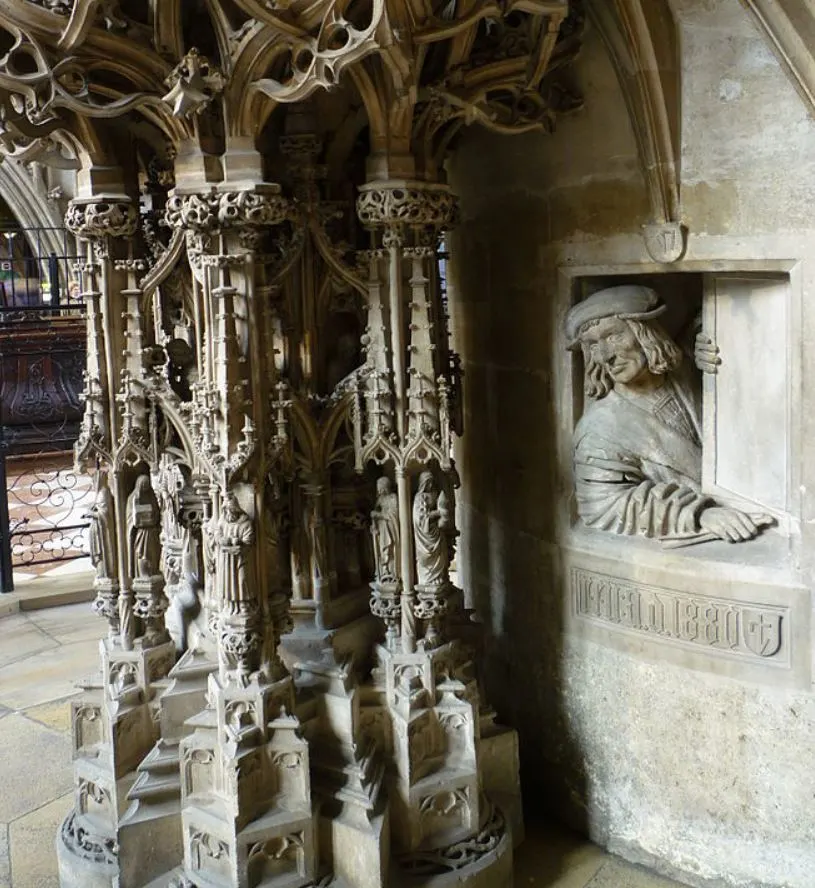
13. Some very famous people are buried inside the church
The Dutch sculptor who created the magnificent pulpit is also responsible for the creation of the tomb of Emperor Frederick III (1415-1493). This work started 25 years before his death and would take 45 years to complete.
He’s far from the only person who ended up being buried in the church as it’s also the final resting place of Prince Eugene of Savoy (1663-1736) and 72 other members of the Habsburg Dynasty of the Austrian Empire whose remains are in the crypt.

14. The south tower was completely restored in the 2000s
During the 2000s, the exterior of the church has been restored as the accumulated dirt turned most parts of the stones completely black. The most prominent feature of the church, the south tower, was restored as well.
This restoration project, which mostly involved cleaning the limestone) was finally completed in the year 2008 and the south tower pretty much looks brand new again!
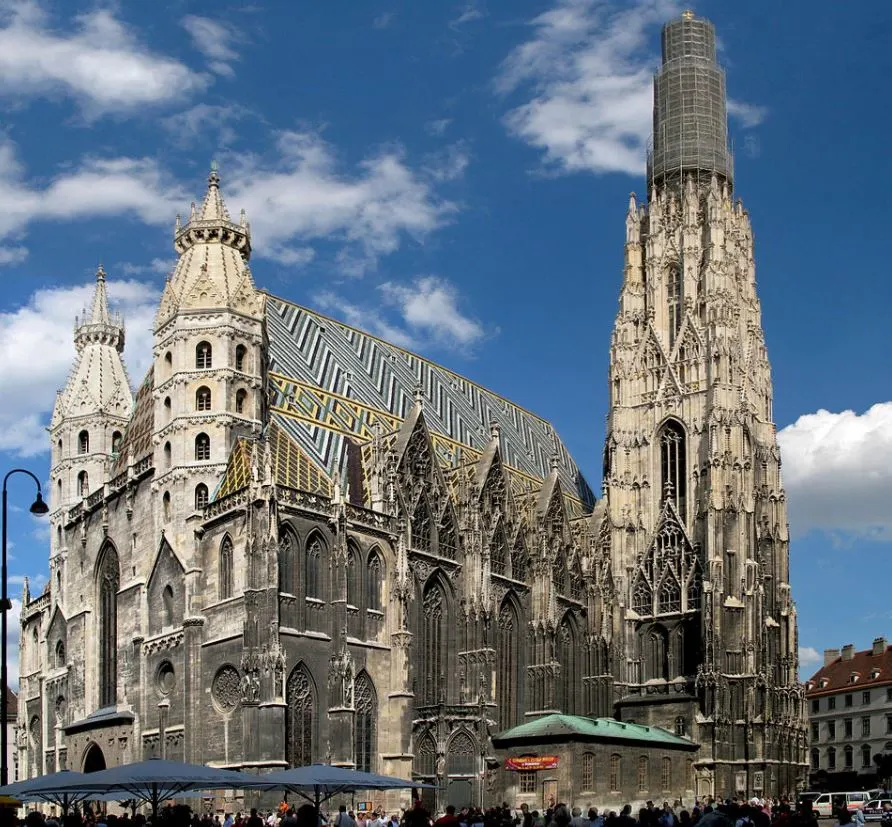
15. The interior looks amazing after a renovation as well
One of the most fascinating facts about St. Stephen’s Cathedral is that the interior looks amazing as well, especially following a similar renovation project.
The cathedral features several chapels which are adorned with statues and amazing works of art. This means that entering the church is a must-do item on your Vienna bucket list!
